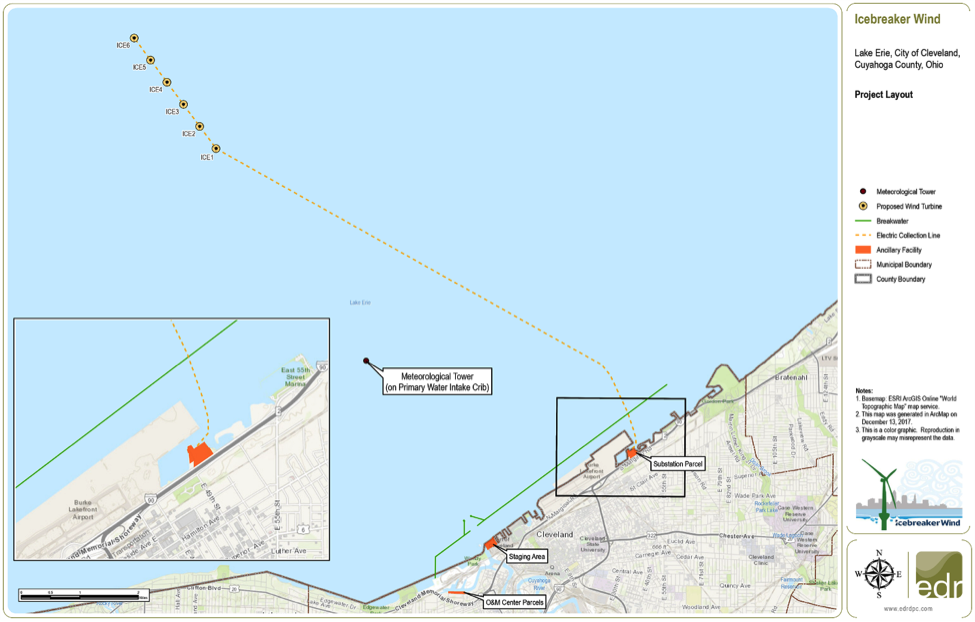The Department of Energy (DOE) has proposed to provide funding for the first U.S. freshwater offshore wind facility, a 20.7 megawatt project in Lake Erie, approximately eight miles off the coast of Cleveland, Ohio. DOE published a Final Environmental Assessment for the Icebreaker Wind project, consisting of six turbines, being developed by Norwegian-owned Fred. Olsen Renewables and the Lake Erie Energy Development Corporation, in cooperation with the U.S. Army Corps of Engineers and the U.S. Coast Guard. The demonstration project includes a submerged transmission cable of almost 12 miles that will be considered separately from the 500-foot high turbines, each consisting of 3.45 megawatts. The project is estimated to cost $126 million. Construction is currently planned for the summer of 2020, with operation beginning later that year.
According to the company’s website, “Lake Erie is an ideal location for offshore wind, with ample available interconnect capacity, large load centers along the coast, growing energy demand due to existing plant retirements, a strong manufacturing base, and limited other sources of renewable energy.” Icebreaker Wind is expected to create over 500 jobs in Northeast Ohio and is projected to have a $168 million local economic impact over the project’s 25 year lifespan.

Concerns of the Opposition
Opponents of the project raised concerns about risks to wildlife, particularly birds and bats, which the DOE assessment noted would be minor due to the small size of the project. Fish and Wildlife officials estimate over 30 million birds die annually from collisions with power lines, communications towers, buildings, and wind turbines. The company is expected to study bird and bat collisions during two years of operation, and determine if the turbines are safe enough to spin at night when most migration occurs. Opponents also raised concerns over oil leakage risks from the turbines, particularly since the project would be located in freshwater. Again, DOE noted the impacts would be minimal. Another concern of the wind farm opponents is that the Icebreaker demonstration project would open Lake Erie and the other Great Lakes to a thousand or more wind turbines in the future.
Background
DOE initiated the National Environmental Policy Act process for this project in 2016 and published the Final Environmental Assessment in 2018. To date, Lake Erie Energy Development Corporation’s Icebreaker project has received nearly $13.7 million in funding from DOE. The project is eligible for up to $37 million in additional funding in future project performance periods after reaching specific milestones and after DOE progress reviews.
Conclusion
The Icebreaker Wind project is an offshore wind project in Lake Erie that will consist of six large wind turbines in freshwater. The project is partially funded by DOE as a demonstration project. Opponents worry about bird and bat kills and the extension of the project to many more turbines in the Great Lakes, among other issues. The capital cost of the Icebreaker wind project is over $6,000 per kilowatt, which is six times more than a natural gas combined cycle plant, and three to four times as much as an onshore wind plant. It is unclear why a technology that is so expensive should be co-funded by U.S. taxpayers.



